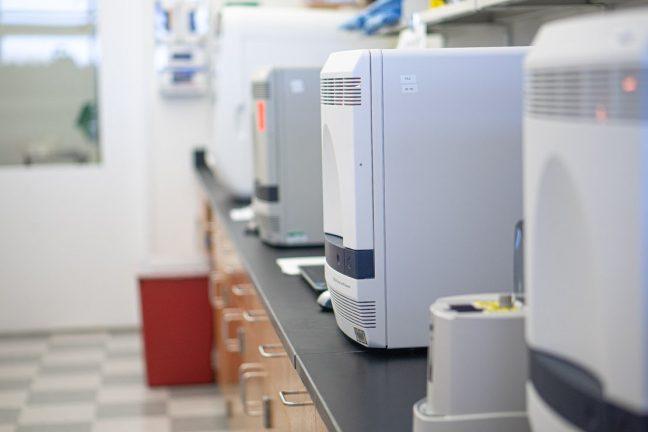The Wisconsin State Laboratory of Hygiene partnered with University of Wisconsin colleagues to expand COVID-19 testing across the state.
According to UW News, in response to the surge of over 1 million COVID-19 cases around the world and more than 2,500 cases in Wisconsin, the WSLH ran thousands of tests for COVID-19 in the state.
In its widespread testing, the WSLH used a COVID-19 virus test developed by the Centers for Disease Control and Prevention.
The WSLH tests rely on the CDC’s development of a Real-Time probe-based polymerase chain reaction.
According to UW News, the reaction identifies trace amounts of the virus’s genetic material by detecting the RNA molecule. In testing, researchers need to convert the virus’s RNA into DNA.
To do this, the enzyme translates one type of genetic code to another. The reaction also requires a thermal cycler machine, which permits scientists to make replicates of the genetic material so there is enough of it to measure, according to UW News.
Assistant Director of the Communicable Disease Division at the WSLH Alana Sterkel spoke about how the necessary COVID-19 testing equipment is in high demand and extremely low supply.
UW research team analyzes travel, social media data to monitor COVID-19 spread
“One of the major limitations in bringing [COVID-19 testing] up in different areas has been the availability of resources,” Sterkel said. “Just like that toilet paper flew off the shelves, all of the lab supplies flew off the shelves, everybody wanted it at the same time in much larger quantities.”
Sterkel said the major supplier for many of these collection kits was stationed in Italy, a country hit incredibly hard by the COVID-19 pandemic.
Because of this, the suppliers’ ability to produce the necessary swabs and other testing tools was incredibly limited. Due to additional federal regulations, it was also difficult to get the kits made in Italy into the United States, Sterkel said.
Knowing about these limitations, Wisconsin took a different approach to testing. The state focused on collaboration to accumulate supplies to distribute and provide COVID-19 testing across the state, Sterkel said.
Director of the Wisconsin Veterinary Diagnostic Laboratory Keith Poulsen spoke about the importance of taking a “One Health” perspective in collaborating human and animal health to combat obstacles in COVID-19 testing.
“When [WSHL] first started dealing with the shortages, they ran out of the nucleic acid extraction kits,” Poulsen said. “These kits extract the RNA from a nasal swab, and because they were in such short supply, [WSHL] began looking for different types of extraction kits.”
UW research team analyzes travel, social media data to monitor COVID-19 spread
Poulsen and WVDL first donated an automated nucleic acid extractor that provides an automated way to take a clinical sample and extract the RNA from it. They transferred equipment such as this to WSHL, trained them to use it and are providing continued support.
The next COVID-19 testing shortage emerged from transport media, tubes that hold nasal swabs and carry it to the lab. As a result of this low supply of commercial media, WVDL began to provide its excess media and swabs to WSHL, according to Poulsen.
“We make about ten thousand units of viral transport media for them a week and the state lab itself makes their own media as well,” Poulsen said. “We are sending the media to the State Emergency Operations Center and the state is distributing it out to the different hospitals and clinics.”
WVDL and WSHL are beginning to work on collaborative research to better understand the future and present impacts of COVID-19 on the population. WVDL worked to donate most of its personal protective equipment and other equipment to focus resources on the human lab, Poulsen said.
Looking onward, Poulsen said there are essential steps that need to be taken to control and understand COVID-19 in its potential future reemergence and scope of infection retrospectively.
“If you want to control a disease, you have to have a reliable test to get an accurate prevalence and some sort of control mechanism, whether that is right now staying at home, developing a vaccine, or an antibiotic if there is a bacterial component,” Poulsen said. “The next big step will be developing a serology test, a blood test to look for antibodies.”
Poulsen said the serology test will help to retrospectively see how many people the virus infected.
Dane County launches plan to protect homeless amidst COVID-19 pandemic
The test detects antibodies that take weeks to develop against the hidden COVID-19 presence in the body, Poulsen said.
“When human healthcare and veterinary medicine work together, they can be much more effective than when they work apart,” Poulsen said. “Wisconsin has excellent examples of human and animal health working together, we are further along than many states because of the type of university we are at and our long history of working together.”
Sterkel said before the COVID-19 pandemic, laboratory workers were typically a forgotten part of the medical field.
Every year, Sterkel and the WSHL celebrate Lab Week to recognize the immense contributions laboratories across Wisconsin make in their fields.
“Workers have done incredible work in such a short amount of time to make COVID-19 testing available to more and more people every day,” Sterkel said.
Lab Week will start the week of April 19 and provides another avenue to give appreciation to the hard work of all facets of the healthcare and medical field, Sterkel said.













